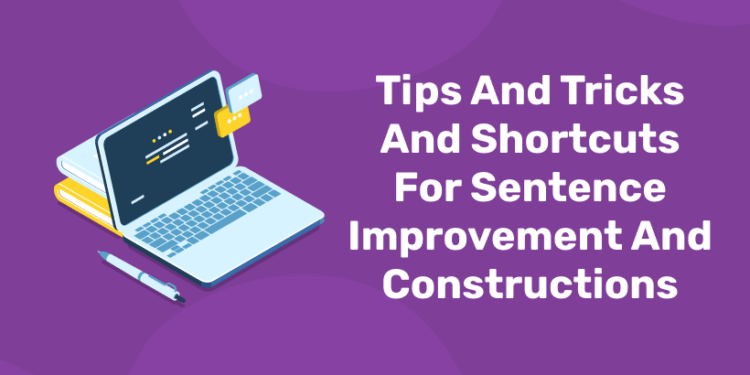Table of Contents
Sentence Improvement is one of the most vital portions that entice a great concern of the aspirants of teaching exams. Almost every contender hopes to score as better as they can by simply hitting the basic grammar rules. Fundamentals of grammar may or may not be essential but the tricks and tips should always be done by heart to avoid errors. The methods are always better than the knowledge involved. In many teaching exams like CTET, UPTET, Goa TET & HTET, etc. The English section will contain questions based on reading comprehension, sentence formation, synonyms & antonyms, grammatical mistakes, and so on. Sentence Improvement is one of the most scoring topics under the English Language and Grammar sections of teaching exams.
The Significance of Improving Sentence Structure
Imagine seeing all the parts for a house laid out in front of you. You know approximately where things should go, but putting the pieces in the wrong order won’t have a very good final product. You can end up with something that looks like a house but has lots of concerns in style and function.
This jumbled box often happens in our writing as well. We have all the parts that we need, but the order in which they appear leaves us lacking the style we wanted and leaves our writing not entirely right for our readers.
Tips, Tricks and Shortcuts For Sentence Improvement
1: Which of the sentences below is grammatically correct?
Start your sentence with the subject, followed by the verb and object. This structure is generally used to build sentences in the English language and is abbreviated “SVO.” Sentences are written in different word orders and often seem illogical or backward. So, rather than writing “A jump was made by the dog onto the sofa,” write “The dog jumped onto the sofa.”
- The subject is the person or thing doing an action (in our instance, the dog).
- The object is the person or thing to which the action is done (in our instance, the sofa).
- The SVO structure is used to construct simple sentences. When you make compound and complex sentences, you’ll add to this basic format.
Write in the active voice to explain the action taking place. When you write in the active voice, you make it clear who or what is functioning a specific action. Using the passive voice outcomes in weak and potentially ambiguous sentences in most situations. Sentences in the passive voice also often have a jumbled, confusing format. So, note the subject of your sentence first, and explain the action that the subject is performing.
- Avoid writing something like: “The trash was taken out by my father before my little sister was dropped off by the school bus.”
- Instead, try writing: “My father took out the trash before the bus dropped off my little sister.”
Change your sentence length and structures to avoid boring your readers. If every sentence in a paragraph starts with a similar phrase, is approximately the same length, or has a similar pattern of words, the sentences will begin to seem dull and repetitive. To avoid this, vary the sentence structures. Try making some sentences longer, joining sentences with conjunctions and semicolons, and creating other sentences shorter and more direct.
- You can connect two short sentences, which are independent clauses, into a single longer sentence by adding a comma and conjunction between them. You can remember your conjunctions by employing the acronym FANBOYS, which helps you remember “for,” “and,” “but,” “or,” “yet,” and “so.”
- If you have one full sentence and one unfinished or subordinate sentence, you can integrate them into a complex sentence with a comma or by adding a conjunction like “because,” “although”, “since, or ” while.” The full sentence is an independent clause, while the unfinished sentence develops into a dependent or subordinating clause.
- Add transitional words and phrases to the fronts of your sentences to make a flow between your ideas. Otherwise, your sentences might seem jerky.
- So, avoid writing sentences like: “First, I went to the supermarket. Then, I went to the art-supply store. Then, I bought a pizza for lunch.”
- Instead, modify the structure to something like: “My first errand was a trip to the supermarket. After that, I went to the art-supply store before buying a pizza for lunch.”
Keep a consistent verb tense in your sentences. As sentences lengthen, it can be effortless to lose track of the tense (e.g., past, present, or future) in which you’re writing the sentence. In almost all cases, it’s both confusing and grammatically incorrect to switch verb tense in the middle of a sentence.
- This sentence switches tenses: “Jane drove to the mall and will buy a pair of jeans.”
- Corrected, it reads: “Jane drove to the mall and bought a pair of jeans.”
Write with parallel structure when writing a list or sequence. If you make a sentence that represents two or more objects or actions, the distinct elements must be defined using the same grammatical terms. If the depictions are not parallel, the sentence becomes confusing. Keeping verb tense the same is an essential part of keeping parallel structure.
- For instance, this sentence doesn’t include parallel structure: “On my day off, I relish stopping at the bank, mow the lawn, and have a conversation with my neighbor.”
- Corrected, it reads: “On my day off, I relish stopping at the bank, mowing the lawn, and having a conversation with my neighbor.”
Download the ENTRI Learning App Now and Join the Best English Learning App!
Use a semicolon to join two independent clauses. If you’d rather not use a period or conjunction to join two independent clauses, place a semicolon between the clauses rather. Adding a semicolon is a great method to convert two simple sentences into one compound sentence, and lets you connect sentences whose central ideas are closely related.
- For example, this sentence includes a semicolon in the wrong location since it is not between the independent clauses: “If you get a chance; stop at the store on your drive cottage, I’d like a gallon of milk.”
- Corrected, it would read: “If you get a chance, stop at the store on your drive cottage; I’d like a gallon of milk.”
Add a colon to sentences to present a list or a noun phrase. Also, use a colon to show a quotation in your sentence. A colon sets apart the words that pursue it and draws attention to them. If you forget the colon from a sentence, it will have an awkward feel and confuse readers.
-
- For example, it’s correct to write, “I had four classes in college today: Chemistry, Physics, biology, and American Literature.”
- You can also write, “As they drove their getaway, the bank robbers forgot something crucial: the loot from the safe.”
Employ commas to join two clauses or set off a descriptive clause. To connect two independent clauses, which are full sentences, put a comma and one of your FANBOYS between them. As another choice, use a comma to set off dependent or subordinating conjunction. Likewise, you’ll put commas on either side of a descriptive clause to set it apart from the rest of the sentence.
-
- For example, you might unite two independent clauses like this: “I completed my homework early today, so my best friend came over to hang out.”
- You could enter a dependent and independent clause like this: “Since my scores are good this term, my parents said I can have a party this weekend.”
- If you had a descriptive clause, here’s how you’d possess it in your sentence: “I want to try that new pizza place, the one with pepperoni on its sign, when we go out on Sunday.”
Tips and Tricks and Shortcuts for Sentence Improvement and Construction are very important to know because this is a high-scoring topic in the verbal ability examinations. To comprehend the concept properly students must have an understanding of general grammar along with a selection of the right words while constructing the sentences.
For making this easy and understandable the Tips and Tricks for Sentence Improvement and Construction to solve the questions easily. Our ENTRI learning app provides such grammar-related notes for aspiring candidates. The candidates can access and join our learning platform for a better study.













